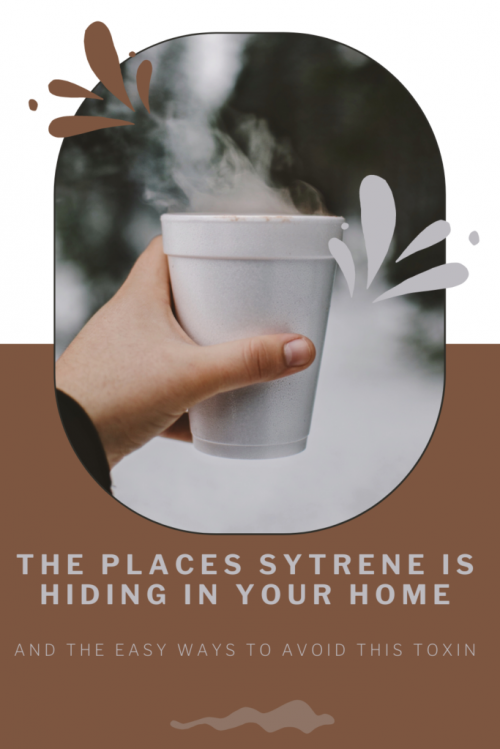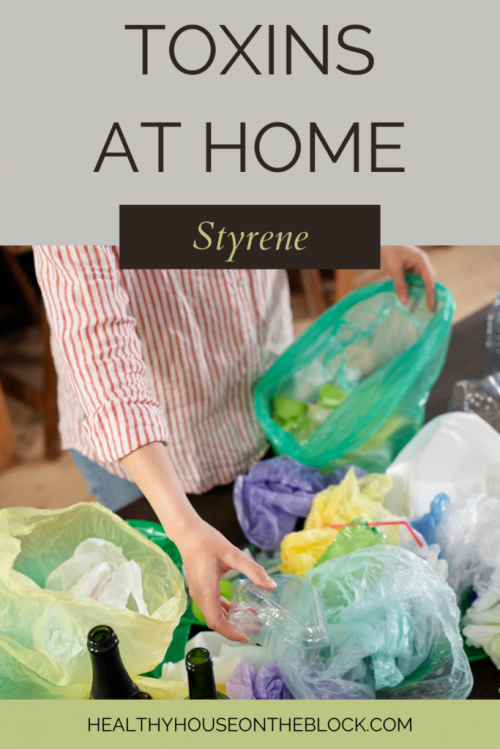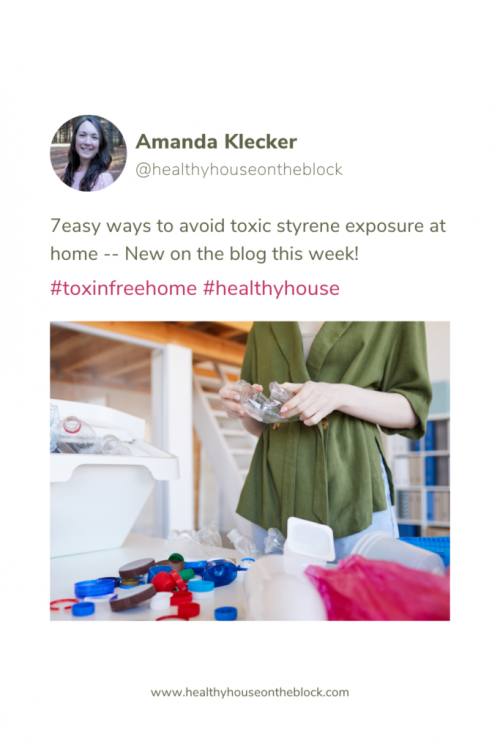
So many of the products we have in and throughout our homes are made from unnatural materials and substances. Styrene, which was originally derived from plants, is now primarily a synthetic chemical. And while originally this meant that it was more cost effective and long lasting, we know now that it’s also exposing us to unnecessary toxins on a constant basis.
I knew that styrene was in a handful of materials throughout my home, such as plastic, synthetic latex and carpet. But what I found out in preparing this blog post was that most of us are constantly exposed to low levels of styrene in the air and water. It’s essentially everywhere at this point.
This is probably even more true if you live near manufacturing plants for plastics and products made of fiberglass materials. When a toxin is very prevalent in the outdoor air, there’s definitely a need to remove it from your indoor air. This gives your body a break from the toxin whenever you’re home. And if you can keep these big toxins out of your bedroom, you’ll really be able to give your body a break.
Styrene is a VOC that gets talked about here and there, but definitely doesn’t get as much attention as other VOCs like Benzene and Formaldehyde. However, because this toxin is in SO many products we buy and building materials we add to our home, it’s important to understand how to avoid it.
And that’s the great news about Styrene, there are some really easy ways to avoid exposures by inhalation and ingestion by just understanding what to buy and what habits can keep you safe.

WHAT IS STYRENE
Styrene is a synthetic, or man-made chemical and a VOC. Originally it was mostly derived from plants through isolating particular elements. However, no it is almost all synthetic. It’s a clearish liquid that is a petroleum byproduct used in manufacturing a variety of fiberglass, plastic and rubber products. It has a low molecular weight, so as a volatile organic compound it tends to migrate to the atmosphere, where we inhale the toxin. Tobacco smoke also produces styrene vapors, which contribute to indoor air exposure of the toxin.
Styrene is used in the production of plastics and rubber products. It’s also used in creating products with fiberglass, such as insulation or boats. During the manufacturing of products that use styrene it can also leach into groundwater from chemical disposal. Styrene has been found to be in almost all urban and suburban atmospheric air at low levels, which means we are exposed via inhalation most of the time outside
Not only does Styrene exposure happen through inhalation of vapors, but also through ingesting the toxin in contaminated food and water.
The most common type of styrene exposure through ingestion is likely through styrofoam cups and plastic food containers that can get warmed by beverages and food, allowing the toxin to leach into whatever is being consumed. This, in my opinion, is also the most dangerous form of exposure.

WHERE STYRENE IS FOUND IN YOUR HOME
Styrene can be found in a number of products in and throughout your home. It’s used in so many industrial products that we use on a daily basis. A large portion of toys contain styrene as to plumbing pipes made of ABS, many 3-D printed materials, and food containers.
Here a few of the big places you can find styrene around your home:
- Synthetic Rubber
- Plastic Packaging
- Insulation
- Disposable Cups & Containers
- Synthetic Latex
- Carpet and Rug Backing
- Plastics
- Printing Cartridges
- ABS PIpes and Plumbing Fittings
- Fiberglass Materials
- 3D Printing Filament

HOW WE ARE EXPOSED TO STYRENE
Styrene can be ingested or inhaled generally.
Because styrene is a VOC and present in most outdoor urban air, we breathe in this toxin daily. There’s more concern for children and infants who inhale styrene toxins as they have higher inhalation rates per unit body weight. Their metabolic capability is also immature, which means the toxin stays in their body for a longer period of time before they can get rid of it. SOURCE
Styrene is also ingested through food stored in plastic containers or beverages consumed out of styrofoam. Styrene migrates from food packaging materials and styrofoam to foods and beverages touching it. When we consume food from these items, we’re also consuming some Styrene. SOURCE
Children who mouth and chew on toys have been found to ingest small amounts of styrene in plastic and synthetic rubber toys. And again, this is of greater concern as their bodies cannot process and detox this VOC as quickly as an adult might. SOURCE

HEALTH EFFECTS OF STYRENE
The good news about Styrene is that it has been tested and studied showing it is not an endocrine disruptor. However, there are other problems that this toxin exposure poses for those who come into contact with it even at low exposure rates.
The big red flag is that because Styrene is classified as a mutagen, it also means it’s potentially carcinogenic to humans. In fact, Styrene has been anticipated to be a probable carcinogen to humans, as it has already been shown as carcinogenic to animals.
Styrene also has many harmful side effects on the central nervous system, causing significant negative changes to the nervous system itself. It has also been shown to cause memory loss, difficulties in concentration and learning, brain and liver damage. In line with these cognitive issues, Styrene has been linked to poorer visual and sensory function in those with moderate exposure to the chemical.
In pregnant women, Styrene exposure at moderate levels has been linked to low birth weight as well as reduced fertility in otherwise healthy women.
And finally, Styrene is a contributor to chronic diseases and accelerates the onset and progression of these diseases in otherwise healthy individuals.

HOW TO AVOID STYRENE PRODUCTS
As I mentioned before, the good news is that there are some VERY easy and simple ways to reduce the exposure of Styrene in your home. Most of these tactics are along the lines of avoiding Styrene from coming into your home, but even if Styrene products do come inside, there are ways to reduce the off-gassing and leaching that may occur.
Avoid Styrofoam and Recycling Code “6”: Polystyrene, or styrofoam, is a HUGE exposure we can avoid probably entirely. Avoid using styrofoam containers and cups and avoid anything with recycling code “6” on it, which likely contains Styrene. Bring a reusable mug for coffee and if you end up getting take out in styrofoam, simply switch it to a plate or glass container before you eat or heat it up.
Stop Using Plastic Food Containers: Thin, plastic food containers, mostly the one-time-use containers, often contain Styrene within the plastic. Avoid purchasing them for your home, and if you do get them with take out food, be sure to move your food to a safe container or plate right away and then recycle the plastic container. (Don’t reuse it)
Never heat food in plastic containers: Styrene leeches out of plastics when they are heated and warmed. NEVER heat your food in plastic containers if you can help it. Instead, transfer food to a plate or to a glass container.

Avoid Cigarette Smoke: Whenever you can, avoid being exposed to secondhand smoke or smoke affected items. Cigarette smoke contains styrene fumes, which can be inhaled, exposing our body to the toxin.
Replace Carpet with a Non-Toxic Option: Because the backing of carpet and rugs contains styrene, a huge improvement to your home may be to replace carpet with a non-toxic option. I am in no way saying rip out perfectly good carpet before you have the means to replace it. But, if you know you’ll be replacing it in the future, do your research now to find a great toxin free carpet, hard surface floor or rug instead.
If you just can’t replace the carpet at this time, don’t worry! You can always try AFM Safecoat’s VOC blocking carpet system as an alternative.
Stick to Natural Latex & Rubber (GOLS Certified): Whenever you’re purchasing items that are typically made from rubber or latex (mattresses, pillows, toys), be sure to purchase something that is made from natural latex or natural rubber. If you can find the GOLS certification, it’s an even better option.
Enclose All Insulation: Fiberglass insulation in attics and basements should be fully enclosed. Any spot where the insulation batting is exposed can allow the fine particles to become loosened. They’ll then end up in your home, in your house dust and in your ducts, allowing tiny particles to be inhaled by you and your family. If you do have exposed insulation, simply have it covered with a vapor barrier or drywall.

We may not be able to control outside air and potential exposures when we’re outside our home. However, when we’re at home we have more control over what comes inside and over what we purchase and buy. The understanding of Styrene and what it is can give you a great start in creating a healthier home for you and your family.




Pingback: TCE (Trichloroethylene) Toxins: A Deep Dive »
Hi, thank you for covering this topic.
We have just installed a new bathtub and I am very concerned because we found out it is made of high impact polystyrene. We thought it was acrylic.
What is your opinion of high impact polystyrene bathtubs? I was looking forward to soaking in the tub. Now, not so sure.. also, the plastic is readily scratched by my nail!
What do you think!!?
I unfortunately don’t love this option. High impact polystyrene has been reported to create microplastic particles that can be fairly concerning. It’s also a type of styrene, which we know is a toxin that in high doses causes liver damage and tissue damage over time. I wish I had different information for you, Rita!